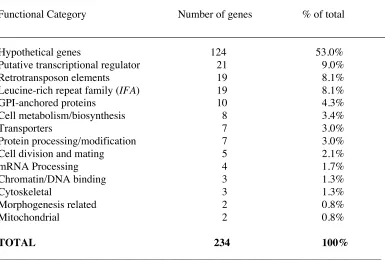COMPARATIVE GENOMICS USING CANDIDA ALBICANS DNA MICROARRAYS REVEALS ABSENCE AND DIVERGENCE OF VIRULENCE ASSOCIATED GENES IN CANDIDA DUBLINIENSIS
Full text
Figure




Related documents
This paper is focused on the compensation of cutting forces in a XY high speed milling table using a sliding mode control (SMC).. The performance of the sliding mode
In this investigation, the transdermal patches (control) and nanoemulsion containing transdermal patches were prepared, compared and characterized for different
The model is then imported to Ansys workbench and the impact analysis is done using four different materials namely Aluminium alloy (6061), Stainless steel, structural steel
Pro12Ala allele is a genetic risk factor for insulin resistance and T2DM.. Pro12Ala polymorphism has genetic susceptibility
Straight ahead, intercept LON R-258 to D7 LON, turn RIGHT, intercept 272^ bearing towards WOD to D13 LON, turn LEFT, intercept SAM R-035 inbound to SAM.. Cross appropriate
Hajič, “Non-projective dependency pars- ing using spanning tree algorithms,” in Proceedings of the conference on Human Lan- guage Technology and Empirical Methods in Natural
The proposed approach produces smaller mean squared error in estimating causal treatment effects than many existing approaches including the well-known covariate balance
In this dissertation we introduce three advances to the deep generative modeling area: Maximum Entropy Flow Networks, a method for maximum entropy modeling; a new [0 ,


![Fig. 3 Southern hybridisation analysis of C. albicans and C. dubliniensis DNA with [α-P32]dATP labeled](https://thumb-us.123doks.com/thumbv2/123dok_us/964194.609630/37.595.68.392.162.365/fig-southern-hybridisation-analysis-albicans-dubliniensis-dna-labeled.webp)


